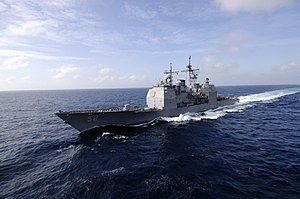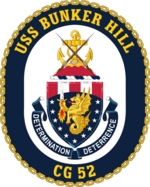USS Bunker Hill (CG-52)

USS Bunker Hill (CG-52) underway
|
|
| History | |
|---|---|
|
|
|
| Name: | USS Bunker Hill |
| Namesake: | Battle of Bunker Hill |
| Ordered: | 15 January 1982 |
| Builder: | Ingalls Shipbuilding |
| Laid down: | 11 January 1984 |
| Launched: | 11 March 1985 |
| Commissioned: | 20 September 1986 |
| Homeport: | Naval Base San Diego |
| Identification: | CG-52 |
| Motto: | Determination, Deterrence |
| Nickname(s): | "Bravo" |
| Honors and awards: |
7 Battle "E" Awards |
| Status: | in active service |
| Badge: |  |
| General characteristics | |
| Class and type: | Ticonderoga-class cruiser |
| Displacement: | Approx. 9,600 long tons (9,800 t) full load |
| Length: | 567 feet (173 m) |
| Beam: | 55 feet (16.8 meters) |
| Draft: | 34 feet (10.2 meters) |
| Propulsion: |
|
| Speed: | 32.5 knots (60 km/h; 37.4 mph) |
| Range: | 6,000 nmi (11,000 km) at 20 kn (37 km/h); 3,300 nmi (6,100 km) at 30 kn (56 km/h). |
| Complement: | 33 officers, 27 Chief Petty Officers, and approx. 340 enlisted |
| Sensors and processing systems: |
|
| Armament: |
|
| Aircraft carried: | 2 × Sikorsky SH-60B or MH-60R Seahawk LAMPS III helicopters. |
| Aviation facilities: | Hangar bay, flight deck |
USS Bunker Hill (CG-52) is a Ticonderoga-class guided missile cruiser of the United States Navy laid down by Litton-Ingalls Shipbuilding Corporation at Pascagoula, Mississippi on 11 January 1984, launched on 11 March 1985 and commissioned on 20 September 1986. Bunker Hill is homeported at Naval Base San Diego in San Diego, California.
Bunker Hill was the first Ticonderoga-class cruiser to be equipped with the Mark 41 Vertical Launching System (VLS) in place of the previous ships' twin-arm Mark 26 missile launchers, which greatly improved the flexibility and firepower of the ships by allowing them to fire RGM-109 Tomahawk missiles.
The sea dragon is an awesome beast that is both vigilant and fierce. Grasping a flaming sword, the sea dragon symbolizes the naval prowess and attack capability of the USS Bunker Hill. The flaming sword also represents the revolutionary capability of the vertical launching system first introduced in Bunker Hill. The stars commemorate the eleven battle stars the former USS Bunker Hill (CV-17) earned in the Pacific theater during World War II. Blue and gold are the colors traditionally associated with the Navy and are symbolic of the sea and excellence. The two white bars in the chief represent American courage and purpose as displayed at the Battle of Bunker Hill on 17 June 1775. The red bars symbolize the British assaults on the colonists' entrenchment and the curve below alludes to the hill that the British took at great cost. Battle of Bunker Hill proved to be a rallying point for the Americans, since afterwards the British faced full-scale war. The colonists were formidable opponents at Bunker Hill. The entrenchments or redoubts they built are symbolized by the scarlet hill and battlements. The muskets with bayonets recall the weapons of that battle and the powder horn refers to the New Englander's stand until their ammunition supply was exhausted. The anchor is symbolic of maritime traditions and excellence of achievement.
...
Wikipedia
